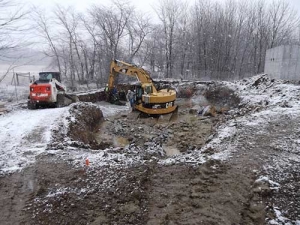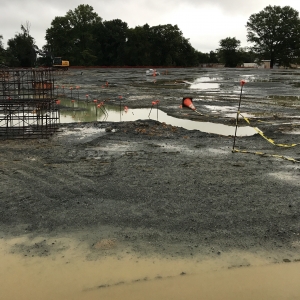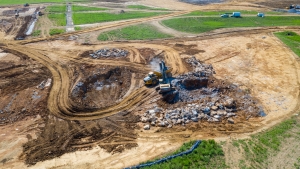60 Things You Might Not Know About Site Work & Excavation
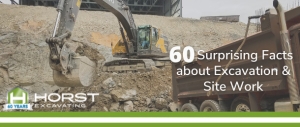
In celebration of our 60th anniversary this year, we thought it would be fun to pull together a post that shares 60 things you may not know about excavation and site work. Which ones are most surprising? Let us know on social media!
Sixty Facts About Excavation & Site Work That You May Not Know
1. Many construction sites do not have the right amount of dirt
They often require the excavating contractor to export dirt that has been displaced and cannot be used in other applications in the project. Other projects may have the opposite problem – not enough dirt – leading to the excavator having an import of dirt brought in to complete the work. You can learn more in this article.
2. Site planning is described as further defining the functional layout for specific buildings or functions and their site.
It often includes three phases – identification, evaluation, and implementation. ^
3. Contractually, excavation contractors can fall into two categories – a prime contractor or a subcontractor.
As a prime contractor, the excavator is working directly for the owner. As a subcontractor, the excavator works for the owner more indirectly, holding a contract with the general contractor or construction manager.
4. The heavy dirt work portion of a project is highly weather-dependent.
It must be meticulously planned in accordance with the owner’s schedule, time of year, and typical weather conditions for the geographic area. Heavy rains that saturate the ground can make doing any type of earthwork difficult, as mud gets caught in the machines and must be scraped out regularly. Windy weather, very cold weather that causes the ground to freeze, and snow are also conditions that can have a significant impact on a project’s schedule. This article provides additional detail about how weather impacts construction projects.
5. Being off by even fractional amounts can cost significant money when it comes to site work.
Selecting a site contractor known for their painstaking attention to detail is prudent for budget-conscious owners.
6. Professionals inside the excavation industry must perform a great deal of research when purchasing new equipment, gaining an understanding of the various applications the piece can handle as well as their lifespan.
Sometimes a piece of heavy equipment must be run 10 hours a day nonstop for weeks or even months!
7. There are four main types of excavation – earth, muck, topsoil, and rock.
8. Earth excavating means removing the ground fill below the layer of topsoil.
9. Earth excavation is done to make way for below-grade equipment, foundations, and grading.
10. Muck excavating is when very wet soil is removed from the ground.
11. Soil gathered during muck excavation cannot be used until the water has evaporated.
12. Topsoil excavation refers to the removal of the top layer of soil and vegetation so that earth excavation and compaction can take place.
13. Topsoil excavating is required to create compacted soil to support the structural loads of buildings.
14. Rock excavation takes place when rock must be removed.
It often requires large pieces of rock to be broken into pieces first – either with excavation equipment or via blasting.
15. For a video of what blasting looks like on a project, check this out:
16. Rock excavation is typically necessary when making conditions more conducive to the installation of pipes and underground utilities.
17. A common phrase within the site work industry is Cut and Fill.
The term cut refers to the process of removing material from the ground to grade or make room for the next steps such as foundations or underground utilities. Meanwhile, fill is the term used to refer to the displaced materials from this process – consisting of topsoil, rock, etc.
18. The term dredging refers to the process of removing sediment from the beds of rivers, ponds, lakes, and other bodies of water.
19. Dredging is a valuable solution to the removal of particulates and erosion that make their way to bodies of water through rain and wind erosion.
It helps curb flood risk by removing particulate pollution that displaces the water.
20. Grading is the process by which ground level is manipulated.
Excavators will use equipment to spread fill in a particular spot of land to create a smooth, even surface and create a level base for the project.

22. Speaking of stone, few people realize that a stone base is laid in place under athletic fields, with the soil being graded and padding applied atop the rock prior to the turf being laid.
The excavator performing this work must meticulously attend to this step and will likely use lasers or GPS technology to ensure the stone is laid perfectly.
23. When completing the stone base in an athletic field project, even something as seemingly innocuous as the size of the stone can have a substantial impact on how flat you are able to get the surface and the grading precision capabilities.
24. Erosion happens naturally when wind or rain carries away topsoil.
If left unchecked, erosion can wreak havoc on land and cause infertile soil, waterway pollution, flooding, and even landslides. Proper erosion control planning and methods will proactively prevent these devastating issues.
25. Soil erosion methods are varied and may include implementation of fiber rolls, blankets, vegetation, silt socks, erosion fences, stormwater management, riprap, gabions, and strategic grading practices.
26. The use of vegetation on your site naturally curbs soil erosion because the roots from grasses, shrubs, and trees help to hold the topsoil in place against subsurface water flow.
They act as a solid barrier against flowing water.
27. Additionally, vegetation breaks down the force of raindrops falling from the sky and slows surface run off.
28. Since soil erosion is especially challenging on sloped land that makes water runoff more intense, strategically grading those areas to flatten the sloping land can make a great impact.
By cutting and restructuring the land, the ground is stabilized by eliminating the existing slopes. Retaining walls are often used in these scenarios to help keep soil in place.
29. Stormwater management is the process of utilizing a strategy to divert rain runoff and stormwater to proper channels.
This can be done by installing rainwater chutes and runoff pipes, altering the flow of runoff and diverting from areas prone to erosion.
30. These pipes and chutes can direct the water to a designated area to properly manage the runoff, such as a retention basin or rain garden.
31. A rain garden is created by lining a shallow depression with an easy-draining soil mixture of topsoil, sand, and compost.
Hardy native plants are then planted in this basin, offering a way to filter stormwater runoff before releasing slowly back into the ground. To learn more about rain gardens, check out our blog.
32. Rain gardens absorb a significant amount of water – up to 30% more than typical grass.^^
33. A detention basin holds back and releases runoff at the surface, while retention basins maintain a permanent pool of water.
Both are generally larger than rain gardens, contain less plant material, and look more like a meadow than a structured garden.
34. Riprap is rock and rubble strategically placed to act as a barrier from eroding sources.
It is an approach used most often on land near streams, rivers, and shores. These are areas that face constant exposure to flowing water and often experience concentrated stormwater runoff.
35. The use of silt socks on a construction site is commonly used to keep erosion under control as a temporary measure.
Erosion fences may also be used – or a combination of the two. The method employed depends on a site’s layout as well as the guidelines from the local conservation district.
36. Erosion control blankets are placed on top of the soil to keep soil in place by absorbing and slowing down runoff.
They are then buried at the top to keep them in place.
37. These blankets can be made from a variety of materials – including coconut fibers, straw, and manmade fabrics.
38. Having an excavating contractor involved during preconstruction is an important step, as they are among the first on a jobsite.
A knowledgeable excavator will be able to provide valuable insight in the early planning of the project that can impact budget, regulatory requirements, value engineering, and schedule.
39. Soil remediation is the process of removing or neutralizing soil that is contaminated with harmful or undesirable materials.
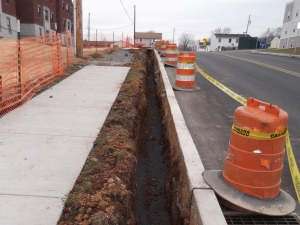
They are dug to house things like utility pipes, cables, sewers, and foundations.
41. You may have heard excavators or construction professionals use the jargon.
One common term is Underground Utilities. This is a very broad term that refers to the necessary hookups for water systems, retention systems, drainage, and the like. However, it can also be used to refer to the creation of pedestrian or recreation paths, bridges, complex infrastructure stations, and more.
42. The equipment used on a jobsite will vary greatly depending on the scope of work and services required.
Popular equipment such as backhoes, dozers, graders, excavators, rollers, scrapers, loaders, articulated trucks, and dump trucks all have very distinct uses. Selecting the appropriate equipment for the job will save the owner time and money by boosting efficiency.
43. Dump trucks and articulated trucks are similar but different.
While an articulate truck is typically larger and more apt to easily access rough terrain, dump trucks are a bit smaller and nimbler. Articulated trucks are used to handle slippery or muddy conditions, climb steep inclines, and haul material or waste across a project site. Dump trucks can more easily travel on paved roads and are used often to haul material off the jobsite (such as when you must export excess dirt).
44. Likewise, backhoes and excavators are in the same “family” of equipment vehicles but have different uses.
Backhoes are usually smaller and can be used in conjunction with a boom for 200-degree rotation and a front loader bucket – making them extremely versatile.
45. Rollers are used by excavation professionals to compact soil on a jobsite.
There are varied sizes and compositions, including vibratory rollers, walk-behind rollers, and more.
46. A scraper is a piece of equipment that is a combination of a loader and a truck.
They are used to cut the dirt and collect it, then carry it across the site and place where needed.
47. Speaking of equipment, the excavator is an impressive multitasker.
This large vehicle typically has a bucket attached via an arm, but there are many other attachments that can be swapped out – such as compactors and breakers. An excavator can be used for digging, demolition, material handling, and much more.
48. The first excavator to use hydraulic technology was built by Sir W.G. Armstrong & Company in England in 1882. ^^^
49. If you want to get a feel for how much rock exists under your site, a geographical engineer can conduct a boring log to show what lies beneath the surface.
They will drill holes into the ground at various locations on the site to detect its composition as well as how deep each layer goes.
50. Although it can become a pricy step, engaging a geotechnical engineer and investing the dollars for a solid geo analysis can save you lots of time and money down the road.
If you do not know what is below the surface throughout your site, you could encounter unforeseen rock – leading to a change order to add the rock removal scope to your contract with the site work professional.
51. The regulations, codes, and permitting requirements are unique in each municipality.
For this reason, advanced planning is crucial in the land development process.
52. Excavation is a crucial piece of the construction plan, and successful projects require site work contractors to understand how their portion of the project will impact the other contractors and the project as a whole.
There are many moving parts to a project and knowledgeable excavators will have a solid big-picture mindset. Effective site work cannot be planned or executed in a vacuum.
53. When it comes to road and infrastructure construction, each state varies in its requirements and prequalification process.
Not all excavators are able to perform heavy/highway construction services, and they must be qualified by each individual state. (Horst Excavating is Penn DOT prequalified)
54. The use of drones to record video and take photos has helped to not only catalog the activities on a construction project site, but also to streamline processes, locate areas of interest more efficiently, and more.
55. The most commonly used terms of measurement in excavation are cubic feet/yards and linear feet/yards.
56. Excavation professionals utilize a variety of technologies to best understand your project.
This includes programs that house historical estimating data for similar projects, technology that aids in takeoff, and even technology within the equipment such as GPS, automated systems, and more.
57. The average age of a construction worker is 42 ½ – making the need for the next generation of leaders greater than ever.
58. There is a shortage of workers in the construction industry, and it is one of the most lucrative careers that do not require a college degree. ^^^^
59. When World War II changed the economic landscape, the female labor force grew by 50% over the span of five years.
After the war’s end, up to 85% of women wanted to keep the jobs they had been working, effectively paving the way for women in the labor force. ^^^^^
60. Women account for about 25% of the construction workforce. ^^^^^^
^ Source | ^^ Source | ^^^ Source | ^^^^ Source | ^^^^^ Source | ^^^^^^ Source
Posted September 03, 2021

